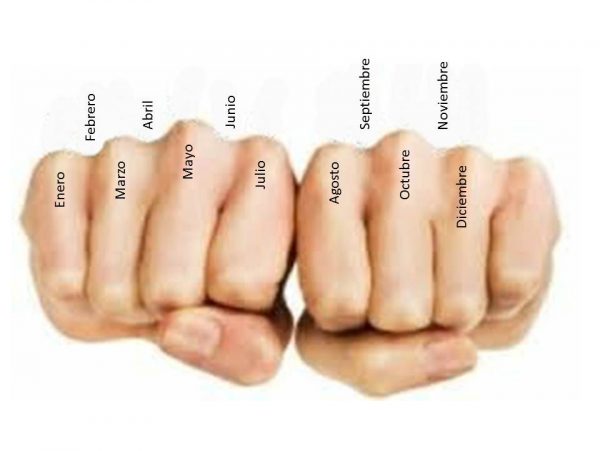The mnemonics It is a system made up of rules and methods that are used to remember or learn something specific: data, years, names, numbers or formulas. The basis of mnemonics is to use a previous knowledge to incorporate a new one.
There are multiple rules and mnemonic techniques that each person can create or adapt according to the concepts they need to remember. For instance: word association, acrostics, or visual mnemonics (like placing a book on the counter so you don’t forget to return it the next day).
The mnemonic rules They are widely used as a memorization technique to remember complicated words, city names or historical dates. They are a tool used by students to memorize concepts from different subjects.
Mnemonic rules often work well with images and many are related to writing. In general, in written mnemonic rules there is no relationship between the word that is used and the one that is to be remembered, but rather they serve as a method of association. For example: If you want to remember the word “Cartagena” you can think of remembering a letter that is from someone else: “Letter from another.”
Characteristics of mnemonics
Some characteristics of mnemonics are:
- It is a method based on repetition.
- It allows associating new concepts with previous or known ideas.
- It allows incorporating part of the personal history of each individual for the memorization of something specific.
- It allows to remember data, dates, names and any type of information.
- It is used by students as a memorization technique.
- It allows each subject to create their own rules and methods according to their needs.
Examples of mnemonics
- Initials method. A list of concepts is memorized through the construction of a new word with the initial of each of the words to remember.
For example: A student wants to remember the countries of North America and creates the word: MEUC, based on the initials of Mexxic, ANDstates ORnests and Cto nothing.
Now the student will memorize that new word created, which will serve as a reference to remember the names of the countries.
- Memory association. Words are associated with experiences of the subject.
For example: If a student wants to remember the name of a new teacher called “Aníbal”, he can associate it with a relative or neighbor of the same name and evoke a memory of that neighbor or relative who is called the same way.
- Word association. Words are associated and it is useful when the order of a sequence must be respected.
For example: A student wants to remember a sequence: “icon, index and symbol”. Associate the initials of the three words: “i, i, s” with names of known people: “Irene and (which would represent the letter “i”) Sol ”and then memorize the phrase.
- Creative word or sentence. An invented word is formed based on the first letters of the concepts to be memorized.
For example: A student has to learn five European capitals and creates the word: MALIROPABE to memorize the names of the cities of: Madrid, Lisboa, Roma, Palaugh and Berlin.
- Story method. Several elements to remember are used to build a story that includes them.
For example: A student wants to remember the year of the conquest of America: 1492. To do so, she invents and memorizes a story that includes the numbers 1, 4, 9 and 2: “The lady of the department 1 visited his neighbor from 4 floor and asked if he would accompany her to buy 9 breads for their 2 sons”.
- Acrostics. The first letter of the concept to be studied is used to form a sentence.
For example: To remember the planets and their order with respect to the Sun (Mercury, Venus, Earth, Mars, Jupiter, Saturn, Uranus, Neptune), a student creates and memorizes the following sentence: “Mi Vhaeja Tía Maria Jmore Supo ORhe Nnumbers”.
- Loci technique. A journey is imagined that is done frequently and objects from that journey are associated with the concepts to be memorized.
For example: A student relates the shops that are on the block of his house with the name of the continents that he has to memorize and puts together a story: “In the first place there is Oceania, which is a bakery, then we pass by the greengrocer where Angelica attends, which is from America. In the clothing store I buy fabrics from Europe, in the bar they sell beers of Asia, I meet Germán just arrived from Africa”.
- Information fragmentation. It is mainly used to memorize long numbers or long, difficult words.
For example: A student has to remember the number: 1536453968, fragments it and forms groups of smaller numbers: 15/36/45/39 / 68. She does the same with the word: radiography, to remember it she separates it into radio and spelling .
- Numerical conversion. A set of numbers to be memorized is associated with consonants.
For example: A student wants to remember the date of the start of the First World War: 1914. Due to the graphic resemblance, he relates 1 with the letter “I”, 9 with the letter “J” and 4 with the letter “A ”, Which forms the word: IJIA, which he will later memorize.
- Visual mnemonics. Images are used to remember something specific.
For example: A girl clenches her hands to memorize the days of the months of the year, the knuckles represent the months that have 31 days and the cavities represent the months that have 30 days (or 28 in the case of February).

